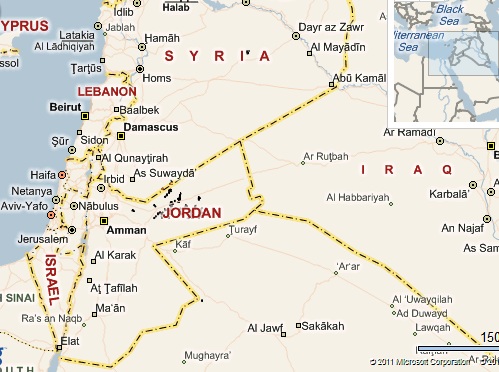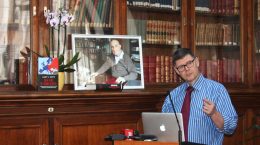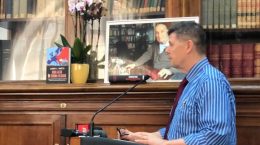 SYRIA: Who is Behind The Protest Movement? Fabricating a Pretext for a US-NATO “Humanitarian Intervention”
SYRIA: Who is Behind The Protest Movement? Fabricating a Pretext for a US-NATO “Humanitarian Intervention”by Prof. Michel Chossudovsky
There is evidence of gross media manipulation and falsification from the outset of the protest movement in southern Syria on March 17th.
The Western media has presented the events in Syria as part of the broader Arab pro-democracy protest movement, spreading spontaneously from Tunisia, to Egypt, and from Libya to Syria.
Media coverage has focussed on the Syrian police and armed forces, which are accused of indiscriminately shooting and killing unarmed “pro-democracy” demonstrators. While these police shootings did indeed occur, what the media failed to mention is that among the demonstrators there were armed gunmen as well as snipers who were shooting at both the security forces and the protesters.
The death figures presented in the reports are often unsubstantiated. Many of the reports are “according to witnesses”. The images and video footages aired on Al Jazeera and CNN do not always correspond to the events which are being covered by the news reports.
There is certainly cause for social unrest and mass protest in Syria: unemployment has increased in recent year, social conditions have deteriorated, particularly since the adoption in 2006 of sweeping economic reforms under IMF guidance. The IMF’s “economic medicine” includes austerity measures, a freeze on wages, the deregulation of the financial system, trade reform and privatization. (See IMF Syrian Arab Republic — IMF Article IV Consultation Mission’s Concluding Statement, http://www.imf.org/external/np/ms/2006/051406.htm, 2006)
With a government dominated by the minority Alawite (an offshoot of Shia Islam), Syria is no “model society” with regard to civil rights and freedom of expression. It nonetheless constitutes the only (remaining) independent secular state in the Arab world. Its populist, anti-Imperialist and secular base is inherited from the dominant Baath party, which integrates Muslims, Christians and Druze.
Moreover, in contrast to Egypt and Tunisia, in Syria there is considerable popular support for President Bashar Al Assad. The large rally in Damascus on March 29, “with tens of thousands of supporters” (Reuters) of President Al Assad is barely mentioned. Yet in an unusual twist, the images and video footage of several pro-government events were used by the Western media to convince international public opinion that the President was being confronted by mass anti-government rallies.
The “Epicenter” of the Protest Movement. Daraa: A Small Border Town in southern Syria
What is the nature of the protest movement? From what sectors of Syrian society does it emanate? What triggered the violence?
What is the cause of the deaths?
The existence of an organized insurrection composed of armed gangs involved in acts of killing and arson has been dismissed by the Western media, despite evidence to the contrary.
The demonstrations did not start in Damascus, the nation’s capital. At the outset, the protests were not integrated by a mass movement of citizens in Syria’s capital.
The demonstrations started in Daraa, a small border town of 75,000 inhabitants, on the Syrian Jordanian border, rather than in Damascus or Aleppo, where the mainstay of organized political opposition and social movements are located. (Daraa is a small border town comparable e.g. to Plattsburgh, NY on the US-Canadian border).
The Associated Press report (quoting unnamed “witnesses” and “activists”) describes the early protests in Daraa as follows:
The violence in Daraa, a city of about 300,000 near the border with Jordan, was fast becoming a major challenge for President Bashar Assad, …. Syrian police launched a relentless assault Wednesday on a neighborhood sheltering anti-government protesters [Daraa], fatally shooting at least 15 in an operation that began before dawn, witnesses said.
At least six were killed in the early morning attack on the al-Omari mosque in the southern agricultural city of Daraa, where protesters have taken to the streets in calls for reforms and political freedoms, witnesses said. An activist in contact with people in Daraa said police shot another three people protesting in its Roman-era city center after dusk. Six more bodies were found later in the day, the activist said.
As the casualties mounted, people from the nearby villages of Inkhil, Jasim, Khirbet Ghazaleh and al-Harrah tried to march on Daraa Wednesday night but security forces opened fire as they approached, the activist said. It was not immediately clear if there were more deaths or injuries. (AP, March 23, 2011, emphasis added)
The AP report inflates the numbers: Daraa is presented as a city of 300,000 when in fact its population is 75,000; “protesters gathered by the thousands”, “casualties mounted”.
The report is silent on the death of policemen which in the West invariably makes the front page of the tabloids.
The deaths of the policemen are important in assessing what actually happened. When there are police casualties, this means that there is an exchange of gunfire between opposing sides, between policemen and “demonstrators”.
Who are these “demonstrators” including roof top snipers who were targeting the police.
Israeli and Lebanese news reports (which acknowledge the police deaths) provide a clearer picture of what happened in Daraa on March 17-18. The Israel National News Report (which cannot be accused of being biased in favor of Damascus) reviews these same events as follows:
Seven police officers and at least four demonstrators in Syria have been killed in continuing violent clashes that erupted in the southern town of Daraa last Thursday.
…. On Friday police opened fire on armed protesters killing four and injuring as many as 100 others. According to one witness, who spoke to the press on condition of anonymity, “They used live ammunition immediately — no tear gas or anything else.”
…. In an uncharacteristic gesture intended to ease tensions the government offered to release the detained students, but seven police officers were killed, and the Baath Party Headquarters and courthouse were torched, in renewed violence on Sunday. (Gavriel Queenann, Syria: Seven Police Killed, Buildings Torched in Protests, Israel National News, Arutz Sheva, March 21, 2011, emphasis added)
The Lebanese news report, quoting various sources, also acknowledges the killings of seven policemen in Daraa: They were killed “during clashes between the security forces and protesters… They got killed trying to drive away protesters during demonstration in Dara’a”
The Lebanese Ya Libnan report quoting Al Jazeera also acknowledged that protesters had “burned the headquarters of the Baath Party and the court house in Dara’a” (emphasis added)
These news reports of the events in Daraa confirm the following:
1. This was not a “peaceful protest” as claimed by the Western media. Several of the “demonstrators” had fire arms and were using them against the police: “The police opened fire on armed protesters killing four”.
2. From the initial casualty figures (Israel News), there were more policemen than demonstrators who were killed: 7 policemen killed versus 4 demonstrators. This is significant because it suggests that the police force might have been initially outnumbered by a well organized armed gang. According to Syrian media sources, there were also snipers on rooftops which were shooting at both the police and the protesters.
What is clear from these initial reports is that many of the demonstrators were not demonstrators but terrorists involved in premeditated acts of killing and arson. The title of the Israeli news report summarizes what happened: Syria: Seven Police Killed, Buildings Torched in Protests.
The Daraa “protest movement” on March 18 had all the appearances of a staged event involving, in all likelihood, covert support to Islamic terrorists by Mossad and/or Western intelligence. Government sources point to the role of radical Salafist groups (supported by Israel)
Other reports have pointed to the role of Saudi Arabia in financing the protest movement.
What has unfolded in Daraa in the weeks following the initial violent clashes on 17-18 March, is the confrontation between the police and the armed forces on the one hand and armed units of terrorists and snipers on the other which have infiltrated the protest movement.
Reports suggest that these terrorists are integrated by Islamists. There is no concrete evidence as to which Islamic organizations are behind the terrorists and the government has not released corroborating information as to who these groups are.
Both the Syrian Muslim Brotherhood (whose leadership is in exile in the UK) and the banned Hizb ut-Tahrir (the Party of Liberation), among others have paid lip service to the protest movement. Hizb ut Tahir (led in the 1980s by Syrian born Omar Bakri Muhammad) tends to “dominate the British Islamist scene” according to Foreign Affairs. Hizb ut Tahir is also considered to be of strategic importance to Britain’s Secret Service MI6. in the pursuit of Anglo-American interests in the Middle East and Central Asia. (Is Hizb-ut-Tahrir another project of British MI6? | State of Pakistan).
Hizb ut-Tahrir anti-Assad rally in Tripoli, Lebanon (40 km from Syrian border), April 22, 2011.
Hizb ut-Tahrir is banned in Syria
Syria is a secular Arab country, a society of religious tolerance, where Muslims and Christians have for several centuries lived in peace. Hizb ut-Tahrir (the Party of Liberation) is a radical political movement committed to the creation of an Islamic caliphate. In Syria, its avowed objective is to destabilize the secular state.
Since the Soviet-Afghan war, Western intelligence agencies as well as Israel’s Mossad have consistently used various Islamic terrorist organizations as “intelligence assets”. Both Washington and its indefectible British ally have provided covert support to “Islamic terrorists” in Afghanistan, Bosnia, Kosovo and Libya, etc. as a means to triggering ethnic strife, sectarian violence and political instability.
The staged protest movement in Syria is modelled on Libya. The insurrection in Eastern Libya is integrated by the Libya Islamic Fighting Group (LIFG) which is supported by MI6 and the CIA. The ultimate objective of the Syria protest movement, through media lies and fabrications, is to create divisions within Syrian society as well as justify an eventual “humanitarian intervention”.
Armed Insurrection in Syria
An armed insurrection integrated by Islamists and supported covertly by Western intelligence is central to an understanding of what is occurring on the ground.
The existence of an armed insurrection is not mentioned by the Western media. If it were to be acknowledged and analysed, our understanding of unfolding events would be entirely different.
What is mentioned profusely is that the armed forces and the police are involved in the indiscriminate killing of protesters.
The deployment of the armed forces including tanks in Daraa is directed against an organized armed insurrection, which has been active in the border city since March 17-18.
Casualties are being reported which also include the death of policemen and soldiers.
In a bitter irony, the Western media acknowledges the police/soldier deaths while denying the existence of an armed insurrection.
The key question is how does the media explain these deaths of soldiers and police?
Without evidence, the reports suggest authoritatively that the police is shooting at the soldiers and vice versa the soldiers are shooting on the police. In a April 29 Al Jazeera report, Daraa is described as “a city under siege”.
“Tanks and troops control all roads in and out. Inside the city, shops are shuttered and nobody dare walk the once bustling market streets, today transformed into the kill zone of rooftop snipers.
Unable to crush the people who first dared rise up against him – neither with the secret police, paid thugs or the special forces of his brother’s military division – President Bashar al-Assad has sent thousands of Syrian soldiers and their heavy weaponry into Deraa for an operation the regime wants nobody in the world to see.
Though almost all communication channels with Deraa have been cut, including the Jordanian mobile service that reaches into the city from just across the border, Al Jazeera has gathered firsthand accounts of life inside the city from residents who just left or from eyewitnesses inside who were able to get outside the blackout area.
The picture that emerges is of a dark and deadly security arena, one driven by the actions of the secret police and their rooftop snipers, in which soldiers and protestors alike are being killed or wounded, in which cracks are emerging in the military itself, and in which is created the very chaos which the regime uses to justify its escalating crackdown. (Daraa, a City under Siege, IPS / Al Jazeera, April 29, 2011)
The Al Jazeera report borders on the absurd. Read carefully.
“Tanks and troops control all roads in and out”, “thousands of Syrian soldiers and their heavy weaponry into Daraa”
This situation has prevailed for several weeks. This means that bona fide protesters who are not already inside Daraa cannot enter Daraa.
People who live in the city are in their homes: “nobody dares walk … the streets”. If nobody dares walk the streets where are the protesters?
Who is in the streets? According to Al Jazeera, the protesters are in the streets together with the soldiers, and both the protesters and the soldiers are being shot at by “plain clothes secret police”, by “paid thugs” and government sponsored snipers.
The impression conveyed in the report is that these casualties are attributed to infighting between the police and the military.
But the report also says that the soldiers (in the “thousands”) control all roads in and out of the city, but they are being shot upon by the plain clothed secret police.
The purpose of this web of media deceit, namely outright fabrications –where soldiers are being killed by police and “government snipers”– is to deny the existence of armed terrorist groups. The later are integrated by snipers and “plain clothed terrorists” who are shooting at the police, the Syrian armed forces and local residents.
These are not spontaneous acts of terror; they are carefully planned and coordinated attacks. In recent developments, according to a Xinhua report (April 30, 2011), armed “terrorist groups” “attacked the housing areas for servicemen” in Daraa province, “killing a sergeant and wounding two”.
While the government bears heavy responsibility for its mishandling of the military-police operation, including the deaths of civilians, the reports confirm that the armed terrorist groups had also opened fire on protesters and local residents. The casualties are then blamed on the armed forces and the police and the Bashar Al Assad government is portrayed by “the international community” as having ordered countless atrocities.
The fact of the matter is that foreign journalists are banned from reporting inside Syria, to the extent that much of the information including the number of casualties is obtained from the unverified accounts of “witnesses”.
It is in the interest of the US-NATO alliance to portray the events in Syria as a peaceful protest movement which is being brutally repressed by a “dictatorial regime”.
The Syrian government may be autocratic. It is certainly not a model of democracy but neither is the US administration, which is characterized by rampant corruption, the derogation of civil liberties under the Patriot legislation, the legalisation of torture, not to mention its “bloodless” “humanitarian wars”:
“The U.S. and its NATO allies have, in addition to U.S. Sixth Fleet and NATO Active Endeavor military assets permanently deployed in the Mediterranean, warplanes, warships and submarines engaged in the assault against Libya that can be used against Syria at a moment’s notice.
On April 27 Russia and China evidently prevented the U.S. and its NATO allies from pushing through an equivalent of Resolution 1973 against Syria in the Security Council, with Russian deputy ambassador to the UN Alexander Pankin stating that the current situation in Syria “does not present a threat to international peace and security.” Syria is Russia’s last true partner in the Mediterranean and the Arab world and hosts one of only two Russian overseas naval bases, that at Tartus. (The other being in Ukraine’s Crimea.)” (Rick Rozoff, Libyan Scenario For Syria: Towards A US-NATO “Humanitarian Intervention” directed against Syria? Global Research, April 30, 2011)
The ultimate purpose is to trigger sectarian violence and political chaos within Syria by covertly supporting Islamic terrorist organizations.
What lies ahead?
The longer term US foreign policy perspective is “regime change” and the destabilization of Syria as an independent nation-state, through a covert process of “democratization” or through military means.
Syria is on the list of “rogue states”, which are targeted for a US military intervention. As confirmed by former NATO commander General Wesley Clark the “[The] Five-year campaign plan [includes]… a total of seven countries, beginning with Iraq, then Syria, Lebanon, Libya, Iran, Somalia and Sudan” (Pentagon official quoted by General Wesley Clark).
The objective is to weaken the structures of the secular State while justifying an eventual UN sponsored “humanitarian intervention”. The latter, in the first instance, could take the form of a reinforced embargo on the country (including sanctions) as well as the freezing of Syrian bank assets in overseas foreign financial institutions.
While a US-NATO military intervention in the immediate future seems highly unlikely, Syria is nonetheless on the Pentagon’s military roadmap, namely an eventual war on Syria has been contemplated both by Washington and Tel Aviv.
If it were to occur, at some future date, it would lead to escalation. Israel would inevitably be involved. The entire Middle East Central Asian region from the Eastern Mediterranean to the Chinese-Afghan border would flare up.
Sursa: GlobalResearch.ca
Michel Chossudovsky is an award-winning author, Professor of Economics (Emeritus) at the University of Ottawa, Director of the Centre for Research on Globalization (CRG) and Editor of globalresearch.ca. He is the author of The Globalization of Poverty and The New World Order (2003) and America’s “War on Terrorism” (2005). He is also a contributor to the Encyclopaedia Britannica. His writings have been published in more than twenty languages. He spent a month in Syria in early 2011.
Vezi si: IPOTEZA Siriana. Planul destabilizarii si distrugerii Siriei a aparut pe internet



